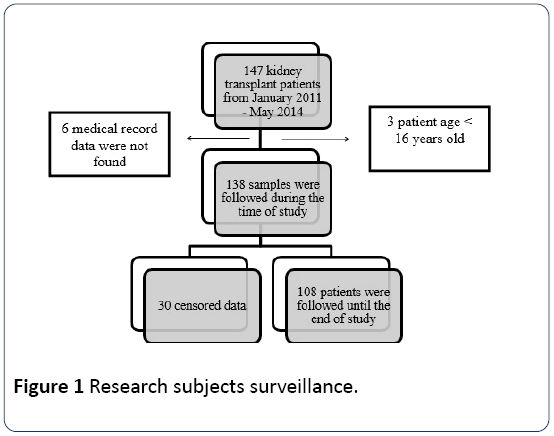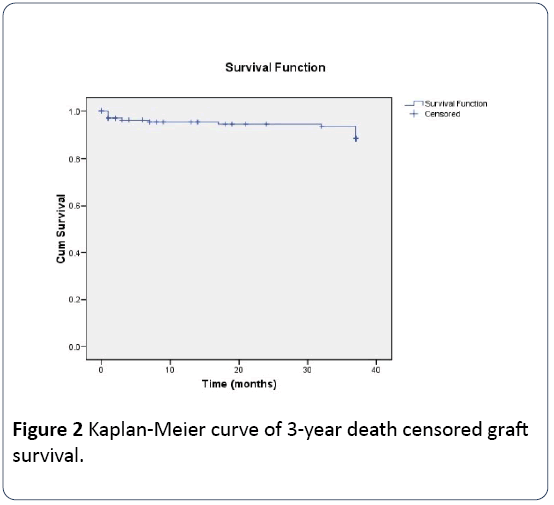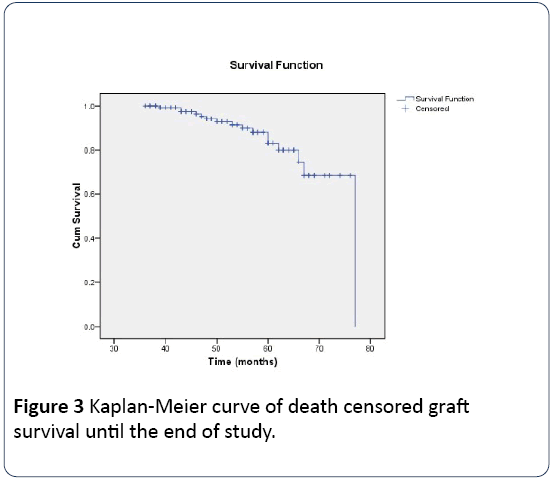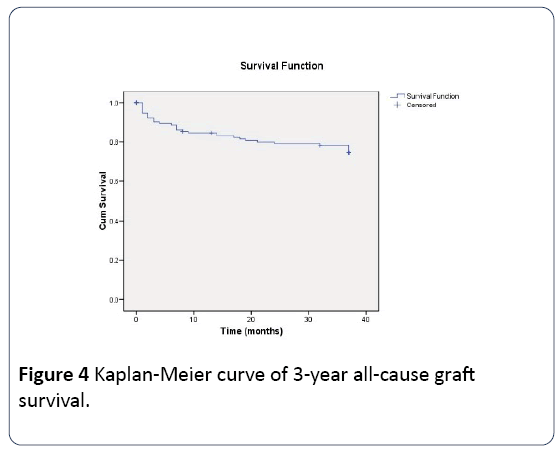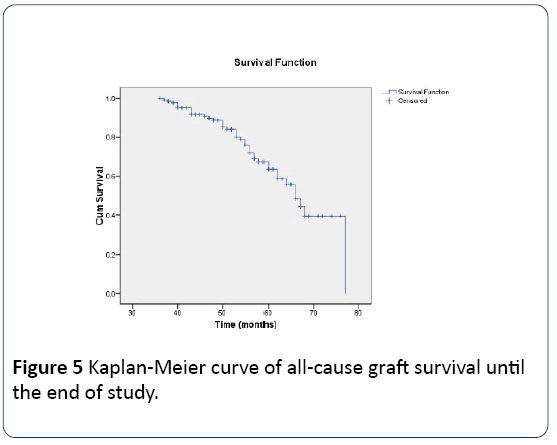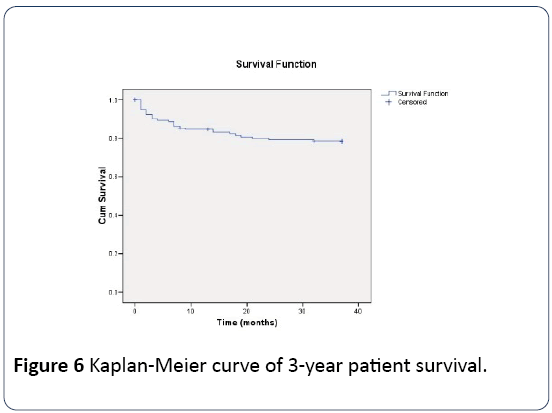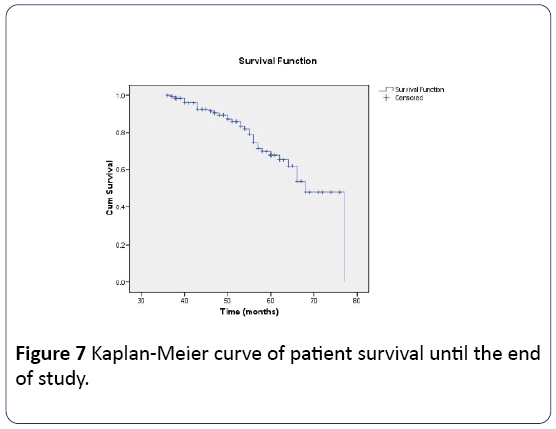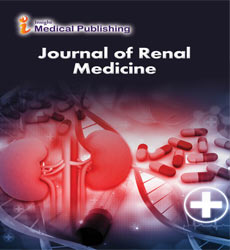A 3-Year Survival Rate of Kidney Transplant Recipient in Cipto Mangunkusumo General Hospital in Indonesia
Vidhia Umami*, Maruhum Bonar H. Marbun and Endang Susalit
Division of Nephrology and Hypertension, Department of Internal Medicine, Faculty of Medicine, Universitas Indonesia, Cipto Mangunkusumo General Hospital, Jakarta, Indonesia
- *Corresponding Author:
- Vidhia Umami
Division of Nephrology and Hypertension
Department of Internal Medicine, Faculty of Medicine, Universitas Indonesia
Cipto Mangunkusumo General Hospital, Jakarta, Indonesia
E-mail: vidhiaumami@yahoo.com
Received Date: August 04, 2017; Accepted Date: August 14, 2017; Published Date: August 17, 2017
Citation: Umami V, Marbun MBH, Susalit E (2017) A 3-Year Survival Rate of Kidney Transplant Recipient in Cipto Mangunkusumo General Hospital in Indonesia. Jour Ren Med. Vol.1 No.2: 11.
Abstract
Background: Kidney transplant has been developing rapidly in Indonesia in recent years. Cipto Mangunkusumo General Hospital (CMGH) has performed 491 transplants in the last 6 years. The survival of graft and patient in CMGH in the first year was 95.4% and 88.5%. However, there was no data on survival in the next following years. This study was aimed to establish the 3-year survival of graft and patient of kidney transplant in CMGH.
Methods and findings: Descriptive study with retrospective cohort design on all kidney transplant patients at CMGH from January 2011 to May 2014. Each patient was observed from the date of transplantation until death or May 2017. Graft and patient survival rate within 3 years and at the end of the study were documented. The Kaplan-Meier method was used to describe graft and patient survival. 138 of 147 kidney transplant recipients were included. All patients receive kidneys from living donors. The mean age was 47.94 + 14.06 years old. The 3-year death-censored graft survival, all-cause graft survival and patient survival were 90.6%, 76.1% and 79.7%, in sequence. At the end of the study, these survival rates were lower (89.1%, 71.7%, and 76.1%). The median of observation time was 42 months (36-72 months). Kaplan-Meier's curve showed the highest mortality rates occurred in the early months. Infection was the main cause of death.
Conclusion: The 3-year graft and patient survival in CMGH 90.6% and 79.7%. Infection is the major factor that affects the survival rates.
Keywords
Chronic kidney disease; Kidney transplant; Graft survival; Patient survival; Survival rate
Introduction
The definitive treatment for end-stage renal disease (ESRD) is renal replacement therapy, which consists of hemodialysis, peritoneal dialysis, and kidney transplant [1]. Kidney transplantation is the best choice in renal replacement therapy since it can improve long-term survival and quality of life in patients. Several studies have shown that kidney transplant recipients have a lower risk of mortality and cardiovascular events, and have a better quality of life than patients undergoing chronic dialysis, both hemodialysis and peritoneal dialysis [2].
In several countries, kidney transplant has been the primary choice of therapy for patients with ESRD [3]. In the United States, until 2013, there have been 17,600 kidney transplants [4]. In Indonesia, kidney transplant has developed rapidly in recent years, particularly in some major health care centers such as Cipto Mangunkusumo General Hospital (CMGC). In the last 6 years there have been 491 kidney transplants in CMGC. So far, all kidney transplants carried out in Indonesia were from living donors [1].
Although it was considered that the graft and patient survival rate will be decreased every year, the difference in the percentage of graft and patient survival in each country is different [2,5,6]. Previously in Indonesia, a study was conducted to observe the characteristics of kidney transplants and graft survival and also patient survival within 1 year after transplantation. However, there haven’t been any studies which observe the survival of graft and patient within 3 years after transplantation.
The aim of this study is to determine the survival of graft and patient in the first 3 years after transplantation and at the end of study in CMGC. This study is expected to be a reference to develop and improve the success rate of kidney transplant in Indonesia and used as a reference for subsequent survival studies with longer time.
Materials and Methods
This research was a descriptive study with retrosepective cohort design which obtained from patient’s medical record data at CMGC in 2011 until 2014. The sample in this study is sorted with total sampling technique. All transplanted patients aged more than 16 years old were included. The subjects of this study were 147 patients who had transplantation in 2011 until 2014 and were observed within 3 years after transplant and until the end of study.
In this study, the precise time of transplant was considered as “initial event”. The time of irreversible rejection of transplant in which patient needs dialysis and/or the time when patients die within 3 years and at the end of study were considered as the “end point event”. All patients who loss to follow up were censored. Kaplan - Meier method was used to determine the survival rate. Data that has been collected were processed with SPSS version 17.0 on the computer. The basic characteristics and clinical research subjects will be presented in tabular form.
Results
Characteristics of the subjects
In general, there are 147 kidney transplant procedures that were performed at CMGH from January 2011 to May 2014. Three patients under 16 years old and 6 patients whose data were not found in the medical record were excluded. There were 30 censored patients and 108 patients were observed until the end of study.
All recipients receive kidneys from living donors. A total of 97 recipients (70.3%) were male. The mean age of transplant recipients was 47.94 + 14.06 years old and the median age of donor at transplant was 31 years old (18 - 64 years). The mean of body mass index (BMI) of the recipient was 22.91 kg/m2.
All patients underwent dialysis before transplantation. There were only 5 patients (3.6%) who underwent peritoneal dialysis before transplantation, while the rest underwent hemodialysis. The shortest duration of hemodialysis was less than 1 month while the longest was 144 months, with median of 8 months. A total of 11 patients have had a previous kidney transplant. A total of 43 (31.2%) patients had renal failure caused by diabetic nephropathy. Pregnancy history before dialysis was found in 33 recipients (82.5% of all female recipients), previous transfusion history was found in 76 recipients (55.1%). Most cross-matching test results were 20% to 30% cell lysis (57.2%) and there were 4 (3.9%) patients that have cross-matching results of 30% to 40% cell lysis. Firstdegree family relationships with recipients (older siblings, siblings, parents, or children) are only found in 44 (31.9%) patients (Figure 1 and Table 1).
| Characteristics | Total = 138 |
|---|---|
| n (%) | |
| Median (min – max) | |
| Mean (SD) | |
| Recipient age (years) | 47.94 (14.06) |
| Donor age (years) | 31 (17 – 64) |
| Sex | |
| Male recipient – male donor | 65 (47.1%) |
| Male recipient – female donor | 32 (23.2%) |
| Female recipient - female donor | 19 (13.8%) |
| Female recipient – male donor | 22 (15.9%) |
| Recipient body mass index (kg/m2) | 22.91 (3.76) |
| Etiology of CKD | |
| Diabetes Mellitus | 43 (31.2%) |
| Hypertension | 37 (26.8%) |
| Glomerulonephritis | 23 (16.7%) |
| Others | 18 (13.0%) |
| Unknown | 17 (12.3%) |
| Comorbidity | |
| Charlson’s Comorbidity Index 0 atau 1 | 70 (50.7%) |
| Charlson’s Comorbidity Index >1 | 51 (37.0%) |
| Data is not available | 17 (12.3%) |
| Diabetes Mellitus | 43 (31.2%) |
| Hemodialysis duration (months) | 8 (1 – 144) |
| Dialysis type | |
| Hemodialysis | 127 (92.0%) |
| Peritoneal Dialysis | 5 (3.6%) |
| Data is not available | 6 (4.3%) |
| Re-transplantation | 11 (8.0%) |
| LFG donor (ml/menit/1.72 m2) | 114.0 (73 – 143) |
| Cross-matching | |
| 0 – 10% | 6 (4.3%) |
| 10 – 20% | 40 (29.0%) |
| > 20 – 30% | 79 (57.2%) |
| > 30 – 40% | 4 (2.9%) |
| Data is not available | 9 (6.5%) |
| Recipient-donor relationship | |
| Related | 44 (31.9%) |
| Not related | 94 (68.1%) |
| Transfusion history | |
| Yes | 76 (55.1%) |
| No | 58 (42.0%) |
| Data is not available | 4 (2.9%) |
| Pregnancy history | 33 (82.5%) |
| Warm ischaemic time I (seconds) | 268 (30 – 977) |
| Cold ischaemic time (minutes) | 23 (13 – 82) |
| Warm ischaemic time II (seconds) | 2653 (608 – 4585) |
| Total ischaemic time (minute) | 75 (54 – 149) |
Table 1: Characteristics of the subjects.
Graft and patient survival in the first 3 years
Graft survival is defined as the percentage of the functioning graft. In the analysis, graft survival was divided into two definitions, there are death censored graft survival where patients who died with functioning graft are considered to have a functioning graft and all-caused graft survival where patients who died with functioning graft are considered to have a failed graft. Patient survival is defined as the percentage of patients who are still alive in 3 years after transplantation or until the end of the study.
In the first 3 years after transplant, 13 of 138 patients (9.4%) experienced graft failure; therefore the 3-year death censored graft survival rate was 90.6%. Eight of them died within 3 years after transplantation. Five patients were alive until the end of study, which four of them were required to undergo hemodialysis and one patient had other transplantation.
In this study, there were 20 patients who died with functioning graft until the third year after transplantation. Therefore, all-cause graft survival was 76.1%.
Twenty-eight patients of 138 recipients died within the first 3 years, thus the 3-year patient survival was 79.7%. Among 28 patients, eight were preceded by graft failure, while 20 (71.4%) patient’s death was caused by other causes (death with functioning graft), such as irreversible sepsis or cardiovascular events, acute myocardial infarction, pulmonary embolism, stroke, or cardiogenic shock.
Graft and patient survival until the end of study
Until the end of study there were 3 additional patients who returned to undergo hemodialysis (two of them died), therefore graft failure was obtained in 16 patients, so the death censored graft survival was 89.1%.
In the end of study, there were 23 patients in total who died with functioning graft, thus the all-cause graft survival rate was 71.7%.
The mean observation time was 42 months (standard deviation 21.2 months, 36-72 months span). Of 138 recipients, 33 patients died until the end of study, so the patient survival rate at the end of study was 76.1%. Among all patients who died, death in patients with a functioning graft (death with functioning graft) was found in 23 patients (69.7%). In 20 patients, death occurred in the first year after transplantation and only 13 cases occurred 1 year after transplantation.
The results of graft and patient survival both in the first 3 years and at the end of the study can be seen in Table 2.
| Variables | 3-Year | The end of study |
|---|---|---|
| Death censored graft survival | 90.6% | 89.1% |
| All-cause graft survival | 76.1% | 71.7% |
| Patient Survival | 79.7% | 76.1% |
Table 2: Graft and patient survival rate within 3 years and at the end of study.
Kaplan-Meier survival curve
The graft and patient survival rate in the first 3 years after transplant and at the end of the study were illustrated by the Kaplan-Meier curve, as shown in the Figures 2-7. The average of observation time is 42 months, minimum time is 1 month and maximum time is 80 months.
Analysis of cause of death
In the first 3 years after transplantation there were 28 patients (20.28%) who died. Eight (28.57%) of them were preceded by graft failure, while 20 patients (71.43%) died of other causes. A total of 8 patients (40%) died of sepsis, 2 patients (10%) died due to acute pulmonary edema, 2 deaths (10%) caused by hepatitis and 1 patient died of stroke. Seven (35%) patient’s cause of death was remaining unknown.
Discussion
Based on this study and previous studies at CMGH, there was a decrease in survival rate in the first 3 years compared to the first year, from 95.4% to 90.6% for graft survival and from 88.5% to 79.7% for patient survival [1]. The same pattern also occurred in the United States but it showed better results than Indonesia. In the United States, in 2012, the 1-year graft survival with living donors was 97% and the 5-year graft survival was 85% [4]. Similar research results in Asian countries also show a decline in survival rates each year. Data from Thai national registry reported that the 1-year survival of patients with living donors from 2009-2013 was 99.0% and this number decreased in the 5-year survival to 95.8% [7]. Likewise, the 1- year graft survival with living donors from 2009-2013 decreased from 97.8% to 91.6%. From Malaysian national registry until 2014, the survival of 1-year graft with living donors was 93% and it decreased to 88% in 3 years after transplantation. The decreased also occurred in 3-year patient survival to 94% from 96% in the first year after transplantation [8]. A study conducted in Iran also stated that there was a decrease in graft survival rates from 1 year to 3 years post transplantation (93.8% to 86.8%) [9].
Based on the data above, it can be concluded that the decrease of graft survival in the third year after transplantation compared to the first year in Indonesia is relatively no different from other Asian countries. This condition shows that immunology factor which is the main factor that affects graft survival is not different in Indonesia than other countries. CMGH applied the immunosuppressant protocols from guidelines that are used widely by other countries so that the risk of graft rejection in Indonesia also has no difference than other countries. On the other hand, the 1-year patient survival in Indonesia is lower than other countries and has decreased more significantly. Some non-immunological factors may contribute to cause low patient survival rate in Indonesia, particularly infectious factors and medication adherence.
Generally, some factors that suspected to affect graft and patient survival have been studied previously. Factors from recipients are serum creatinine levels (p = 0.0001), comorbidity (diabetes mellitus p<0.01), and surgical complications (RR = 5.64) [9-11]. Otherwise, there are some factors from donor such as unrelated donor relations (P = 0.0002) [10]. In Indonesia, the dominant factors from recipients that may affect survival rate are comorbid, infectious disease, and unrelated donors. Other factors that should be considered are patient compliance after transplantation such as adherence to immunosuppressant drug and healthy lifestyle. In some circumstances, patient compliance may be affected by the problem of drug distribution and the distance between patient’s residence and transplantation center.
This study also attempted to determine the survival rate until the end of study. This information is useful to predict survival in the next following years. It is concluded that the survival of graft and patients in the next following years will be decreased. By knowing the factors that affect the survival rates and preventing the occurrence of these factors, it is expected to reduce the decrease of the graft and patient survival.
Conclusion
This is the first study in Indonesia that observed the survival of graft and patients within 3 years after transplantation. The population of this study was obtained from the largest transplantation center that will represent the population of kidney transplant in Indonesia. This study used a total sampling technique so that only a few patients were excluded. On the other hand, this study has several weaknesses. This study did not analyze the risk factors of graft and patient survival because the number of patients is insufficient to be used as research samples. Further research in the future is expected to be done to find survival over a longer period of time and to analyze the factors affecting graft and patient survival.
References
- Harjito FV (2015) A1-year survival of kidney tranplantation recipient in CiptoMangunkusumo General Hospital, Indonesia.
- Adekoya AO, Halawa AD (2016) Kidneys fromdeceased elderly donors: Factor associated with adverse outcomes. Experimental and Clinical Transplantation 1: 32-37.
- Tonelli M, Wiebe N, Knoll G, Bello A, Browne S, et al. (2011) Systematic review: Kidney transplantation compared with dialysis in clinically relevant outcomes. Am J Transplant 11: 2093-2109.
- Levey AS, Weiner DE (2016) US Renal Data System 2015, Annual Data Report: Epidemiology of kidney disease in the United States. Am J Kidney Dis 67:1.
- Shahbazi F, Ranjbaran M, Karami-Far S, Manesh HJ (2015) Graft survival rate of renal transplantation during a period of 10 years in Iran. J Res Med Sci 20: 1046-1052.
- Almasi-Hashiani A, Rajaeefard AR, Hassanzade J, Salahi H, Nikeghbalian S, et al. (2011) Graft survival rate of renal transplantation: A single center experience during 1999-2009. Iran Red Crescent Med J 13: 392-397.
- Thai Transplantation Society (2014) 2014 Annual Report of Kidney Transplantation. Thai Transplantation Society. Bangkok, Thailand.
- Goh BLLY, Ong LM, (2014) 20th Report of The Malaysian Dialysis and Transplant Registry in2014. The National Renal Registry, Malaysian Society of Nephrology,Malaysia.
- Sayyadi H, Zayeri F, Baghestani AR, Baghfalaki T, Afshari AT, et al. (2017) Assessing risk indicators of allograft survival of renal transplant: An application of joint modeling of longitudinal and time-to-event analysis. Iran Red Crescent Med 19: e40583
- Fuggle SV, Allen JE, Johnson RJ, Collett D, Mason PD, et al. (2010) Factors affecting graft and patient survival after live donor kidney transplantation in the UK. Transplantation 89: 694-701.
- Oliveira MI, Santos AM, Salgado Filho N (2012) Survival analysis and associated factors to mortality of renal transplant recipients in a University Hospital in Maranhao. J Bras Nefrol 34: 216-225.
Open Access Journals
- Aquaculture & Veterinary Science
- Chemistry & Chemical Sciences
- Clinical Sciences
- Engineering
- General Science
- Genetics & Molecular Biology
- Health Care & Nursing
- Immunology & Microbiology
- Materials Science
- Mathematics & Physics
- Medical Sciences
- Neurology & Psychiatry
- Oncology & Cancer Science
- Pharmaceutical Sciences
